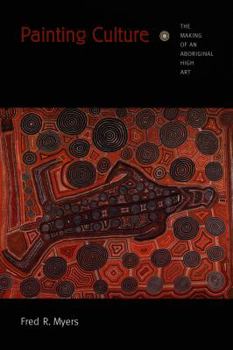Painting Culture: The Making of an Aboriginal High Art
(Part of the Objects/Histories Series)
Painting Culture tells the complex story of how, over the past three decades, the acrylic "dot" paintings of central Australia were transformed into objects of international high art, eagerly sought... This description may be from another edition of this product.
Format:Paperback
Language:English
ISBN:0822329492
ISBN13:9780822329497
Release Date:December 2002
Publisher:Duke University Press
Length:440 Pages
Weight:1.50 lbs.
Dimensions:1.1" x 6.0" x 9.1"
Customer Reviews
1 rating
Great Art Gets Some Deserved Attention
Published by Thriftbooks.com User , 21 years ago
In the 1970s, an Anglo-Australian advisor to the Pintupi Aboriginal people of the remote Western Desert of Australia suggested that they transfer some of their traditional designs to modern European painting media (notably acrylic). The result was astonishing: a seemingly endless stream of brilliant, intense, moving paintings emerging from one of the most remote and impoverished places on earth. By incredible good fortune, Fred Myers, one of the most sensitive and wide-ranging ethnographers in anthropology, was there almost from the birth of the movement, recording what happened. This is his authoritative book on the meteoric rise of an art style that has achieved world reknown. The art is enmeshed in Aboriginal religion, which in turn is enmeshed in the land. Most of the paintings are of religious landscapes. Myers is at his best in explaining the differences between Aboriginal views of the paintings (basically, as religious art connected with land and land rights) and westerners' views (basically, as beautiful pictures). Myers does not make the comparison, but it is rather like looking at Italian Renaissance religious scenes. You can't fully appreciate what's going on (however much you may enjoy the color scheme) if you have no idea who Jesus, Mary, and Mary Magdalene were. Other books have focused on the art and its makers (not only Pintupi; other groups had their own artistic triumphs, and now I am told that most of the artists in Australia belong to the tiny percentage who are of Aboriginal background). Myers thus concerns himself more with the reception that the paintings had in the wider world, and the whole process of winning recognition as "art" for what was once dismissed as mere "aboriginal craft" items--a racist dismissal. Myers is incredibly fair-minded (more than I would have been) to all parties, in the face of this, but sometimes anger inevitably breaks through; for example, after reporting one particularly dismissive review, he says "Here, then, were outsiders who knew more than the participants but did not bother to talk with them, outsiders whose representational practices directly thwarted the representations of Aboriginal painters" (p. 292). Racism took several tactics. First and most odious was attacking the marketing of the paintings as "commodification" or "commoditization"--translation: it's fine for elite white artists to sell their stuff, but Immoral and Sinful for poor and nonwhite folks to make an honest dollar the same way. Related were attacks on the lack of "authenticity" of the art because old-time Aboriginals didn't have acrylic; again, no one attacks elite white artists for using media that Leonardo da Vinci didn't use. Then there was the early consignment of the art to "natural history" museums! (This had changed by the early 1990s.) Another tactic was glib talk of Aboriginals as "the Other," to be "situated in a discourse of alterity" or of "cultural construction" instead of treate




